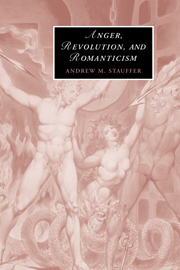Book contents
- Frontmatter
- Contents
- Acknowledgments
- List of abbreviations
- Introduction: fits of rage
- 1 Towards Romantic anger
- 2 Burke, Coleridge, and the rage for indignation
- 3 Inflammatory reactions
- 4 Provocation and the plot of anger
- 5 Shelley and the masks of anger
- 6 Byron's curse
- Epilogue
- Notes
- Bibliography
- Index
- CAMBRIDGE STUDIES IN ROMANTICISM
6 - Byron's curse
Published online by Cambridge University Press: 22 September 2009
- Frontmatter
- Contents
- Acknowledgments
- List of abbreviations
- Introduction: fits of rage
- 1 Towards Romantic anger
- 2 Burke, Coleridge, and the rage for indignation
- 3 Inflammatory reactions
- 4 Provocation and the plot of anger
- 5 Shelley and the masks of anger
- 6 Byron's curse
- Epilogue
- Notes
- Bibliography
- Index
- CAMBRIDGE STUDIES IN ROMANTICISM
Summary
At every stage of his career, from English Bards and Scotch Reviewers (1809) and The Curse of Minerva (1811) to Marino Faliero (1820) and Cain (1821), Byron was writing poetry occasioned and shaped by anger. Yet modern studies of Byron have tended to downplay the importance of that emotion, probably because Don Juan bestrides his poetry like a colossus, and most readers understand the modes and methods of that poem – the digression, the lampoon, the sly wink, the humorous deflation of hypocrisy – as paradigmatic. Furthermore, the many critics who focus on Byron's satires alone (e.g. Beaty, Gleckner, Lockwood, and Jones) exclude a large portion of his poetry of anger and revenge, since Byron characteristically combines satiric impulses with a dramatic sense of himself as a figure of vengeance, producing a kind of generic red-shift. For Byron, the resulting angry poetry – a combination of satire, dramatic curse, and confessional lyric – opposes Romantic sincerity with its theatricality, Romantic sympathy with its alienating effects, and Romantic transcendence with its commitment to mundane cycles of retribution.
Of these aspects of Byron's poetry that challenge Romantic aesthetics, self-dramatization is the most familiar. Thomas Lockwood speaks of the “personal quality in post-Augustan satire,” in which the satirist “makes personal references to himself as well as to the man he is satirizing” (Post-Augustan Satire, 18).
- Type
- Chapter
- Information
- Anger, Revolution, and Romanticism , pp. 133 - 163Publisher: Cambridge University PressPrint publication year: 2005

